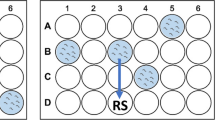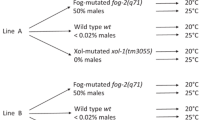Abstract
Entomopathogenic nematodes (EPNs) suffer from trait deterioration, a potential problem when these antagonists are transferred into artificial environments for mass production. In order to improve beneficial traits of EPN genetic selection and hybridization has been successfully carried out. Should these selected strains deteriorate during serial culturing the efforts would be in vain. Inbreeding might offer a possibility to stabilize traits but can also result in inbreeding depression. This study attempted to increase heat tolerance of Heterorhabditis bacteriophora by selective breeding for seven cycles either with nematodes propagated in vivo in Galleria mellonella or with in vitro propagated nematodes which were exposed to heat stress in monoxenic liquid culture. After release of the selection pressure, the tolerance was monitored over 15 additional reproductive cycles to compare the stability of the trait. Virulence of the selected strains was assessed to check for negative tradeoff effects. Heat tolerance was successfully increased in vivo (from 39.03 to 40.85 °C) and in vitro (from 39 to 40 °C) propagated H. bacteriophora, but could only be maintained in populations which were serially reared in liquid culture. When H. bacteriophora is cultured in vivo, reproduction by cross fertilization is possible. In in vitro culture male and female cannot mate and reproduction is solely by self-fertilizing hermaphrodite resulting in homozygous inbred lines. Trait deterioration seems to be restricted to in vivo propagated H. bacteriophora, whereas monoxenic liquid cultures handling large numbers of inbred lines provided genetically stable and virulent nematode populations. Selection using liquid culture technology is thus superior over in vivo propagation to sustain beneficial traits in H. bacteriophora not only for selective breeding but also for mass production.



Similar content being viewed by others

References
Bai C, Shapiro-Ilan D, Gaugler R, Hopper K (2005) Stabilization of beneficial traits in Heterorhabditis bacteriophora through creation of inbred lines. Biol Control 32:220–227
Bilgrami A, Gaugler R, Shapiro-Ilan D, Adams B (2006) Source of trait deterioration in entomopathogenic nematodes Heterorhabditis bacteriophora and Steinernema carpocapsae during in vivo culture. Nematology 8:397–409
Ciche TA, Darby C, Ehlers R-U, Forst S, Goodrich-Blair H (2006) Dangerous liaisons: the symbiosis of entomopathogenic nematodes and bacteria. Biol Control 38:22–46
de Waal JY, Malan AP, Levings J, Addison MF (2010) Key elements in the successful control of diapausing codling moth, Cydia pomonella (Lepidoptera: Tortricidae) in wooden fruit bins with a South African isolate of Heterorhabditis zealandica (Rhabditida: Heterorhabditidae). Biocontrol Sci Technol 20:489–502
Dembilio O, Llácer E, Martínez de Altube MM, Jacas JA (2009) Field efficacy of imidacloprid and Steinernema carpocapsae in a chitosan formulation against the red palm weevil Rhynchophorus ferrugineus (Coleoptera: Curculionidae) in Phoenix canariensis. Pest Manag Sci 66:365–370
Dolgin SE, Charlesworth B, Baird ES, Cutter DA (2007) Inbreeding and outbreeding depression in Caenorhabditis nematodes. Evolution 61:1339–1352
Ehlers R-U (2001) Mass production of entomopathogenic nematodes for plant protection. Appl Microbiol Biotechnol 56:623–633
Ehlers R-U (2003) Biocontrol nematodes. In: Hokkanen HMT, Hajek AE (eds) Environmental impacts of microbial insecticides. Kluwer, Dordrecht, The Netherlands, pp 177–220
Ehlers R-U (2007) Entomopathogenic nematodes: from science to commercial use. In: Vincent C, Goettel MS, Lazarvits G (eds) Biological control—a global perspective. CABI International, Wallingford, UK, pp 136–151
Ehlers R-U, Shapiro-Ilan DI (2005) Mass production. In: Grewal PS, Ehlers RU, Shapiro-Ilan DI (eds) Nematodes as biocontrol agents. CABI International, Wallingford, UK, pp 91–106
Ehlers R-U, Lunau S, Krasomil-Osterfeld K, Osterfeld KH (1998) Liquid culture of the entomopathogenic nematode–bacterium–complex Heterorhabditis megidis/Photorhabdus luminescens. BioControl 43:77–86
Ehlers R-U, Oestergaard J, Hollmer S, Wingen M, Strauch O (2005) Genetic selection for heat tolerance and low temperature activity of the entomopathogenic nematode-bacterium complex, Heterorhabditis bacteriophora–Photorhabdus luminescens. BioControl 50:699–716
Grewal PS, Selvan S, Gaugler R (1994) Thermal adaptation of entomopathogenic nematodes: niche breadth for infection, establishment and reproduction. J Therm Biol 19:245–253
Grewal PS, Wang X, Taylor R (2002) Dauer juvenile longevity and stress tolerance in natural population of entomopathogenic nematodes: is there a relationship? Int J Parasitol 32:717–725
Grewal PS, Bornstein-Forst S, Burnell AM, Glazer I (2006) Physiological, genetic, and molecular mechanisms of chemoreception, thermobiosis, and anhydrobiosis in entomopathogenic nematodes. Biol Control 38:54–65
Han R, Ehlers R-U (2000) Pathogenicity, development and reproduction of Heterorhabditis bacteriophora and Steinernema carpocapsae under axenic in vivo conditions. J Invertebr Pathol 75:55–58
Hastings IM (1994) Introduction to quantitative genetics: inbreeding, heritability estimates and artificial selection. In: Burnell AM, Ehlers R-U, Mason JP (eds) Genetics of entomopathogenic nematode-bacterium complexes. European Commission Publication EUR 15681 EN, Luxembourg, pp 143–151
Hirao A, Ehlers R-U (2010) Influence of inoculum density on population dynamics and dauer juvenile yields in liquid culture of biocontrol nematodes Steinernema carpocapsae and S. feltiae (Nematoda: Rhabditida). Appl Microbiol Biotechnol 85:507–515
Hopper KR, Roush RT, Powell W (1993) Management of genetics of biological-control introductions. Annu Rev Entomol 38:27–51
Hoy MA (1985) Recent advances in genetics and genetic improvement of the Phytoseiidae. Annu Rev Entomol 30:345–370
Johnigk S-A, Ehlers R-U (1999) Juvenile development and life cycle of Heterorhabditis bacteriophora and H. indica. Nematology 1:251–260
Johnigk SA, Hollmer S, Strauch O, Wyss U, Ehlers R-U (2002) Heritability of the liquid culture mass production potential of the entomopathogenic nematode Heterorhabditis bacteriophora. Biocontrol Sci Technol 12:267–276
Kaya HK, Stock SP (1997) Techniques in insect nematology. In: Lacey LA (ed) Manual of techniques in insect pathology. Biological techniques series, Academic Press, San Diego, USA, pp 281–325
Lunau S, Stoessel S, Schmidt-Peisker AJ, Ehlers R-U (1993) Establishment of monoxenic inocula for scaling up in vitro cultures of the entomopathogenic nematodes of Steinernema spp. and Heterorhabditis spp. Nematologica 39:385–399
Martinez de Altube MM, Strauch O, Fernandez de Castro G, Martinez Peña A (2008) Control of the flat-headed root borer Capnodis tenebrionis (Linné) (Coleoptera: Buprestidae) with the entomopathogenic nematode Steinernema carpocapsae (Weiser) (Nematoda: Steinernematidae) in a chitosan formulation in apricot orchards. BioControl 53:531–539
Mukuka J, Strauch O, Waeyenberge L, Viaene N, Moens M, Ehlers R-U (2010a) Heat tolerance among different strains of the entomopathogenic nematode Heterorhabditis bacteriophora. BioControl 55:423–434
Mukuka J, Strauch O, Hoppe C, Ehlers R-U (2010b) Major improvement of heat and desiccation tolerance in Heterorhabditis bacteriophora through cross-breeding of tolerant strains and successive genetic selection. BioControl 55:511–521
Peters A (2000) Insect based assay for entomopathogenic nematode infectiousness definitions, guidelines, problems. IOBC/WPRS Bull 23(2):109–114
Roush RT (1990) Genetic considerations in the propagation of entomophagous species. In: Baker RR, Dunn PE (eds) Critical issues in biological control. Liss, New York, USA, pp 373–387
Shapiro D, Glazer I, Segal D (1996) Trait stability and fitness of the heat tolerant entomopathogenic nematode Heterorhabditis bacteriophora IS5 strain. Biol Control 6:238–244
Shapiro-Ilan DI, Gouge DH, Piggott SJ, Patterson FJ (2006) Application technology and environmental considerations for use of entomopathogenic nematodes in biological control. Biol Control 38:124–133
Strauch O, Stoessel S, Ehlers R-U (1994) Culture conditions define automictic or amphimictic reproduction in entomopathogenic rhabditid nematodes of the genus Heterorhabditis. Fundam Appl Nematol 17:575–582
Stuart RJ, Gaugler R (1996) Genetic adaptation and founder effect in laboratory populations of the entomopathogenic nematode Steinernema glaseri. Can J Zool 74:164–170
Susurluk A, Ehlers R-U (2008) Field persistence of the entomopathogenic nematode H. bacteriophora in different crops. BioControl 53:627–641
Toepfer S, Burger R, Ehlers R-U, Peters A, Kuhlmann U (2010) Controlling western corn rootworm larvae with entomopathogenic nematodes: effect of application techniques on plant-scale efficacy. J Appl Entomol 134:467–479
Wang X, Grewal PS (2002) Rapid genetic deterioration of environmental tolerance and reproductive potential of an entomopathogenic nematode during laboratory maintenance. Biol Control 23:71–78
Wright DJ, Peters A, Schroer S, Fife JP (2005) Application technology. In: Grewal PS, Ehlers R-U, Shapiro-Ilan DI (eds) Nematodes as biocontrol agents. CABI International, Wallingford, UK, pp 91–106
Acknowledgments
Thanks to Dr. Arne Peters for advice and constructive suggestions. The scholarship to the first author by the Deutscher Akademischer Austauschdienst (http://www.daad.de) and to the PINC (http://www.pinc.ugent.be) master student N. H. Sumaya by VLIR (http://www.vlir.be) is highly appreciated.
Author information
Authors and Affiliations
Corresponding author
Additional information
Handling Editor: Eric Wajnberg
Rights and permissions
About this article
Cite this article
Anbesse, S., Sumaya, N.H., Dörfler, A.V. et al. Stabilisation of heat tolerance traits in Heterorhabditis bacteriophora through selective breeding and creation of inbred lines in liquid culture. BioControl 58, 85–93 (2013). https://doi.org/10.1007/s10526-012-9467-x
Received:
Accepted:
Published:
Issue Date:
DOI: https://doi.org/10.1007/s10526-012-9467-x



